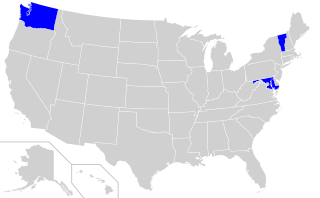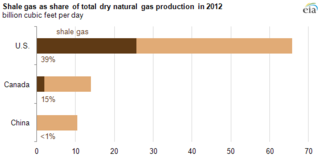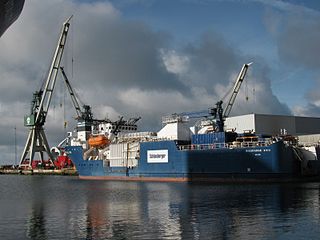Related Research Articles

Fracking in the United States began in 1949. According to the Department of Energy (DOE), by 2013 at least two million oil and gas wells in the US had been hydraulically fractured, and that of new wells being drilled, up to 95% are hydraulically fractured. The output from these wells makes up 43% of the oil production and 67% of the natural gas production in the United States. Environmental safety and health concerns about hydraulic fracturing emerged in the 1980s, and are still being debated at the state and federal levels.

Shale gas is an unconventional natural gas that is found trapped within shale formations. Since the 1990s a combination of horizontal drilling and hydraulic fracturing has made large volumes of shale gas more economical to produce, and some analysts expect that shale gas will greatly expand worldwide energy supply.

Water testing is a broad description for various procedures used to analyze water quality. Millions of water quality tests are carried out daily to fulfill regulatory requirements and to maintain safety.

Well stimulation is a well intervention performed on an oil or gas well to increase production by improving the flow of hydrocarbons from the reservoir into the well bore. It may be done using a well stimulator structure or using off shore ships / drilling vessels, also known as "Well stimulation vessels".
The Fracturing Responsibility and Awareness of Chemicals Act was a 2009 legislative proposal in the United States Congress to define hydraulic fracturing as a federally regulated activity under the Safe Drinking Water Act. The proposed act would have required the energy industry to disclose the chemical additives used in the hydraulic fracturing fluid. The gas industry opposed the legislation.

Fracking is a well stimulation technique involving the fracturing of formations in bedrock by a pressurized liquid. The process involves the high-pressure injection of "fracking fluid" into a wellbore to create cracks in the deep-rock formations through which natural gas, petroleum, and brine will flow more freely. When the hydraulic pressure is removed from the well, small grains of hydraulic fracturing proppants hold the fractures open.
Range Resources Corporation is a natural gas exploration and production company headquartered in Fort Worth, Texas. It operates in the Marcellus Formation, where it is one of the largest land owners.

A proppant is a solid material, typically sand, treated sand or man-made ceramic materials, designed to keep an induced hydraulic fracture open, during or following a fracturing treatment, most commonly for unconventional reservoirs. It is added to a fracking fluid which may vary in composition depending on the type of fracturing used, and can be gel, foam or slickwater–based. In addition, there may be unconventional fracking fluids. Fluids make tradeoffs in such material properties as viscosity, where more viscous fluids can carry more concentrated proppant; the energy or pressure demands to maintain a certain flux pump rate that will conduct the proppant appropriately; pH, various rheological factors, among others. In addition, fluids may be used in low-volume well stimulation of high-permeability sandstone wells to the high-volume operations such as shale gas and tight gas that use millions of gallons of water per well.

Fracking in the United Kingdom started in the late 1970s with fracturing of the conventional oil and gas fields near the North Sea. It was used in about 200 British onshore oil and gas wells from the early 1980s. The technique attracted attention after licences use were awarded for onshore shale gas exploration in 2008. The topic received considerable public debate on environmental grounds, with a 2019 high court ruling ultimately banning the process. The two remaining high-volume fracturing wells were supposed to be plugged and decommissioned in 2022.

Fracking has become a contentious environmental and health issue with Tunisia and France banning the practice and a de facto moratorium in place in Quebec (Canada), and some of the states of the US.

Environmental impact of fracking in the United States has been an issue of public concern, and includes the contamination of ground and surface water, methane emissions, air pollution, migration of gases and fracking chemicals and radionuclides to the surface, the potential mishandling of solid waste, drill cuttings, increased seismicity and associated effects on human and ecosystem health. Research has determined that human health is affected. A number of instances with groundwater contamination have been documented due to well casing failures and illegal disposal practices, including confirmation of chemical, physical, and psychosocial hazards such as pregnancy and birth outcomes, migraine headaches, chronic rhinosinusitis, severe fatigue, asthma exacerbations, and psychological stress. While opponents of water safety regulation claim fracking has never caused any drinking water contamination, adherence to regulation and safety procedures is required to avoid further negative impacts.

Sarnia's Chemical Valley and the surrounding area are home to sixty-two facilities and refineries. A 2007 Ecojustice Canada report showed those industrial facilities located within 25 km of Sarnia, Ontario, Canada emitted more than 131,000 tonnes of air pollution in 2005.

The environmental impact of fracking is related to land use and water consumption, air emissions, including methane emissions, brine and fracturing fluid leakage, water contamination, noise pollution, and health. Water and air pollution are the biggest risks to human health from fracking. Research has determined that fracking negatively affects human health and drives climate change.

There are many exemptions for fracking under United States federal law: the oil and gas industries are exempt or excluded from certain sections of a number of the major federal environmental laws. These laws range from protecting clean water and air, to preventing the release of toxic substances and chemicals into the environment: the Clean Air Act, Clean Water Act, Safe Drinking Water Act, National Environmental Policy Act, Resource Conservation and Recovery Act, Emergency Planning and Community Right-to-Know Act, and the Comprehensive Environmental Response, Compensation, and Liability Act, commonly known as Superfund.

The Marcellus natural gas trend is a large geographic area of prolific shale gas extraction from the Marcellus Shale or Marcellus Formation, of Devonian age, in the eastern United States. The shale play encompasses 104,000 square miles and stretches across Pennsylvania and West Virginia, and into eastern Ohio and western New York. In 2012, it was the largest source of natural gas in the United States, and production was still growing rapidly in 2013. The natural gas is trapped in low-permeability shale, and requires the well completion method of hydraulic fracturing to allow the gas to flow to the well bore. The surge in drilling activity in the Marcellus Shale since 2008 has generated both economic benefits and considerable controversy.

Countries using or considering to use fracking have implemented different regulations, including developing federal and regional legislation, and local zoning limitations. In 2011, after public pressure France became the first nation to ban hydraulic fracturing, based on the precautionary principle as well as the principal of preventive and corrective action of environmental hazards. The ban was upheld by an October 2013 ruling of the Constitutional Council. Some other countries have placed a temporary moratorium on the practice. Countries like the United Kingdom and South Africa, have lifted their bans, choosing to focus on regulation instead of outright prohibition. Germany has announced draft regulations that would allow using hydraulic fracturing for the exploitation of shale gas deposits with the exception of wetland areas.

Groundwater pollution occurs when pollutants are released to the ground and make their way into groundwater. This type of water pollution can also occur naturally due to the presence of a minor and unwanted constituent, contaminant, or impurity in the groundwater, in which case it is more likely referred to as contamination rather than pollution. Groundwater pollution can occur from on-site sanitation systems, landfill leachate, effluent from wastewater treatment plants, leaking sewers, petrol filling stations, hydraulic fracturing (fracking) or from over application of fertilizers in agriculture. Pollution can also occur from naturally occurring contaminants, such as arsenic or fluoride. Using polluted groundwater causes hazards to public health through poisoning or the spread of disease.

Fracking in Canada was first used in Alberta in 1953 to extract hydrocarbons from the giant Pembina oil field, the biggest conventional oil field in Alberta, which would have produced very little oil without fracturing. Since then, over 170,000 oil and gas wells have been fractured in Western Canada. Fracking is a process that stimulates natural gas or oil in wellbores to flow more easily by subjecting hydrocarbon reservoirs to pressure through the injection of fluids or gas at depth causing the rock to fracture or to widen existing cracks.
Water in Arkansas is an important issue encompassing the conservation, protection, management, distribution and use of the water resource in the state. Arkansas contains a mixture of groundwater and surface water, with a variety of state and federal agencies responsible for the regulation of the water resource. In accordance with agency rules, state, and federal law, the state's water treatment facilities utilize engineering, chemistry, science and technology to treat raw water from the environment to potable water standards and distribute it through water mains to homes, farms, business and industrial customers. Following use, wastewater is collected in collection and conveyance systems, decentralized sewer systems or septic tanks and treated in accordance with regulations at publicly owned treatment works (POTWs) before being discharged to the environment.
Hydraulic fracturing is the propagation of fractures in a rock layer by pressurized fluid. Induced hydraulic fracturing or hydrofracking, commonly known as fracking, is a technique used to release petroleum, natural gas, or other substances for extraction, particularly from unconventional reservoirs. Radionuclides are associated with fracking in two main ways. Injection of man-made radioactive tracers, along with the other substances in hydraulic-fracturing fluid, is often used to determine the injection profile and location of fractures created by fracking. In addition, fracking releases naturally occurring heavy metals and radioactive materials from shale deposits, and these substances return to the surface with flowback, also referred to as wastewater.
References
- ↑ Soraghan, Mike (15 November 2010). "Halliburton Announces Ecofriendly Fracking Fluid, More Disclosure". The New York Times. Retrieved 13 April 2017.
Halliburton Co., which is fighting U.S. EPA about disclosure of its fracking fluid, today announced that it will publicly disclose detailed information on its website about the chemicals used in its fracturing fluids. The Houston-based oilfield services company announced the creation of a new fracturing fluid that uses chemicals "sourced entirely from the food industry."
- ↑ Dr Dave Healy (July 2012). "Hydraulic Fracturing or 'Fracking': A Short Summary of Current Knowledge and Potential Environmental Impacts" (PDF). Department of Geology & Petroleum Geology, University of Aberdeen: 18–19. Retrieved 12 November 2015.
{{cite journal}}: Cite journal requires|journal=(help) - ↑ "The Environmental Permitting (England and Wales) Regulations 2010". UK Government. 2010. Retrieved 2016-08-28.
- ↑ "The Pollution Prevention and Control (Scotland) Regulations 2012". www.legislation.gov.uk. Queen's Printer for Scotland (QPS). Retrieved 1 April 2017.
- ↑ "DIRECTIVE 2006/118/EC OF THE EUROPEAN PARLIAMENT AND OF THE COUNCIL of 12 December 2006 on the protection of groundwater against pollution and deterioration". eur-lex.europa.eu. EUR-Lex - 32006L0118 - EN - EUR-Lex. 12 December 2006. Retrieved 18 October 2014.
It is necessary to distinguish between hazardous substances, inputs of which should be prevented, and other pollutants, inputs of which should be limited. Annex VIII to Directive 2000/60/EC, listing the main pollutants relevant for the water environment, should be used to identify hazardous and non-hazardous substances which present an existing or potential risk of pollution.
- ↑ "Onshore oil and gas exploration in the UK: regulation and best practice" (PDF). DECC/BEIS. p. 46. Retrieved 13 April 2017.
Operators will disclose the chemical additives of fracturing fluids on a well-by-well basis.
- ↑ Mair, Robert (June 2012). Shale gas extraction in the UK: A review of hydraulic fracturing (PDF) (Report). The Royal Society and the Royal Academy of Engineering. Retrieved 3 April 2017.
- 1 2 NLM (August 2015). "Household Products Database". Health and Safety Information on Household Products. U.S. Department of Health and Human Services. Retrieved 11 November 2015.
- ↑ GWPC & IOGCC (2015). "What chemicals are used in a hydraulic fracturing job". Chemical Disclosure Registry. FracFocus. Retrieved 11 November 2015.
- ↑ Nicholas Kusnetz (April 8, 2011). "Fracking Chemicals Cited in Congressional Report Stay Underground". ProPublica. Retrieved July 11, 2011.
- ↑ Chemicals Used in Hydraulic Fracturing (PDF) (Report). Committee on Energy and Commerce U.S. House of Representatives. April 18, 2011. Archived from the original (PDF) on October 4, 2013.
- ↑ "Natural Gas Development Activities and High‐volume Hydraulic Fracturing" (PDF). New York State Department of Environmental Conservation. 30 September 2009. pp. 45–51.